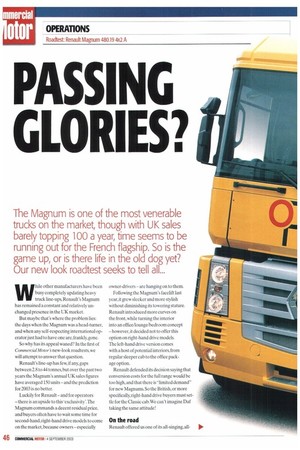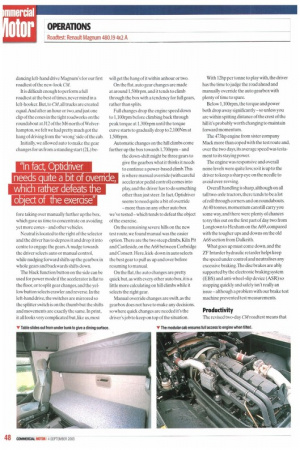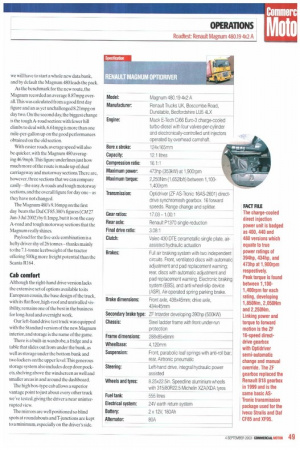PASSING GLORIES?
Page 46

Page 48

Page 49

If you've noticed an error in this article please click here to report it so we can fix it.
The Magnum is one of the most venerable truas on the market, though with UK sales barely topping 100 a year, time seems to be running out for the French flagship. So is the game up, or is there life in the old dog yet?
Our new look roadtest seeKs to tell all...
While other manufacturers have been busy completely updating heavy truck line-ups, Renault's Magnum has remained a constant and relatively unchanged presence in the UK market.
But maybe that's where the problem lies: the days when the Magnum was a head-turner, and when any self-respecting international operator just had to have one are, frankly,gone.
So why has its appeal waned? In the first of Commercial Motor's new-look roadtests,we will attempt to answer that question.
Renault's line-up has few, if any, gaps between 2.8 to 44 tonnes, but over the past two years the Magnum's annual UK sales figures have averaged 150 units — and the prediction for 2003 is no better.
Luckily for Renault — and for operators —there is an upside to this 'exclusivity'.The Magnum commands a decent residual price. and buyers often have to wait some time for second-hand, right-hand drive models to come on the market,because owners— especially owner-drivers — are hanging on to them.
Following the Magnum's facelift last year, it grew sleeker and more stylish without diminishing its towering stature. Renault introduced more curves on the front, while turning the interior into an office/lounge/bedroom concept — however, it decided not to offer this option on right-hand drive models. The left-hand drive version comes with a host of potential interiors,from regular sleeper cab to the office package option.
Renault defended its decision saying that conversion costs for the full range would be too high, and that there is "limited demand" for new Magnums. So the British,or more specifically, right-hand drive buyers must settle for the Classic cab. We can't imagine Daf taking the same attitude!
On the road
Renault offered us one of its all-singing, all dancing left-hand drive Magnum's for our first roadtest of the new-look CM.
It is difficult enough to perform a full roadtest at the best of times, never mind in a left-hooker. But, to CM,all trucks are created equal.And after an hour or two,andjust one clip of the cones in the tight roadworks on the roundabout at J12 of the M6 north of Wolverhampton, we felt we had pretty much got the hang of driving from the 'wrong' side of the cab.
Initially, we allowed auto to make the gear changes for us from a standing start (2L) be fore taking over manually further up the box. which gave us time to concentrate on avoiding yet more cones — and other vehicles.
Neutral is located to the right of the selector and the driver has to depress it and drop it into centre to engage the gears.A nudge towards the driver selects auto or manual control, while nudging forward shifts up the gearbox in whole gears and backwards shifts down.
The black function button on the side can be used for power mode if the accelerator is flat to the floor, or to split gear changes, and the yellow button selects crawler and reverse. In the left-hand drive, the switches are mirrored so the splitter switch is on the thumb but the shifts and movements are exactly the same. In print, it all looks very complicated but, like us, most will get the hang of it within anhour or two.
On the flat. auto gear changes are made at around 1.500rpm, and it tends to climb through the box with a tendency for full gears, rather than splits.
Full changes drop the engine speed down to 1,100rpm before climbing back through peak torque at 1.300rpm until the torque curve starts to gradually drop to 2,100Nna at 1,50Orpm.
Automatic changes on the hill climbs come further up the box towards 1,700rpna — and the down-shift might be three gears to give the gearbox what it thinks it needs to continue a power-based climb. This is where manual override (with careful accelerator pedal control) comes into play, and the driver has to do something other than just steer. In fact, Optidriver seems to need quite a bit of override —more than on any other auto box we've tested — which tends to defeat the object of the exercise.
On the remaining severe hills on the new test route, we found manual was the easier option.There are the two steep climbs, Kiln Pit and Castleside, on the A68 between Corbridge and Consett. Here. kick-down in auto selects the best gear to pull us up and over before resuming to manual.
On the flat, the auto changes are pretty quick but, as with every other auto box, it is a little more calculating on hill climbs while it selects the right gear.
Manual override changes are swift, as the gearbox does not have to make any decisions, so where quick changes are needed it's the driver's job to keep on top of the situation. With 12hp per tonne to play with,the driver has the time to judge the road ahead and manually override the auto gearbox with plenty of time to spare.
Below 1,100rprn, the torque and power both drop away significantly —so unless you are within spitting distance of the crest of the hill it's probably worth changing to maintain forward momentum.
The 473hp engine from sister company Mack more than coped with the test route and, over the two days, its average speed was testament to its staying power.
The engine was responsive and overall noise levels were quite low, so it is up to the driver to keep a sharp eye on the needle to avoid over-revving.
Overall handling is sharp, although on all tail two-axle tractors, there tends to be a lot of roll through corners and on roundabouts. At 40 tonnes, momentum can still carry you some way, and there were plenty of chances to try this out on the first part of day two from Longt own to Hexham on the A69, compared with the tougher ups and downs on the old A68 section from Dalkeith.
What goes up must come down, and the ZF Intarder hydraulic retarder helps keep the speed under control and neutralises any excessive braking.The disc brakes are ably supported by the electronic braking system (EBS) and anti-wheel-slip device (ASR) so stopping quickly and safely isn't really an issue— although a problem with our brake test machine prevented test measurements.
Productivity The revised two-day CM roadtest means that we will have to start a whole new data bank, and by default the Magnum 480 leads the pack.
As the benchmark for the new route, the Magnum recorded an average 8.87mpg overall.This was calculated from a good first day figure and an as yet unchallenged 8.21mpg on day two. On the second day, the biggest change is the tough A-road section: with fewer hill climbs to deal with, 6.61mpg is more than one mile-per-gallon up on the good performances obtained on the old section.
With easier roads, average speed will also be quicker, with the Magnum 480 averaging 46.9mph.This figure underlines just how much more of the route is made up of dual carriageway and motorway sections.There are, however, three sections that we can compare easily — the easy A-roads and tough motorway sections, and the overall figure for day one — as they have not changed.
The Magnum 480's 9.16mpg on the first day beats the Daf CF85.380's figures (CM 27 Jun-3 Jul 2002) by 0.1mpg, but it is on the easy A-road and tough motorway sections that the Magnum really shines.
Payload for the five-axle combination is a hefty driver shy of 26 tonnes —thanks mainly to the 7.1-tonne kerbweight of the tractor offering 500kg more freight potential than the Seania R164.
Cab comfort
Although the right-hand drive version lacks the extensive set of options available to its European cousin, the base design of the truck. with its flat floor, high-roof and unrivalled visibility, remains one of the best in the business for long-haul and overnight work.
Our left-hand drive test truck was equipped with the Standard version of the new Magnum interior, and storage is the name of the game.
There is a built-in wardrobe, a fridge and a table that slides out from under the bunk, as well as storage under the bottom bunk and two lockers on the upper level This generous storage system also includes deep door pock ets, shelving above the windscreen as well and smaller areas in and around the dashboard.
The high box-type cab allows a superior vantage point to just about every other truck we've tested, giving the driver a near uninterrupted view.
The mirrors are well positioned so blind spots at roundabouts and T-junctions are kept to a minimum, especially on the driver's side.
















































































































































































































